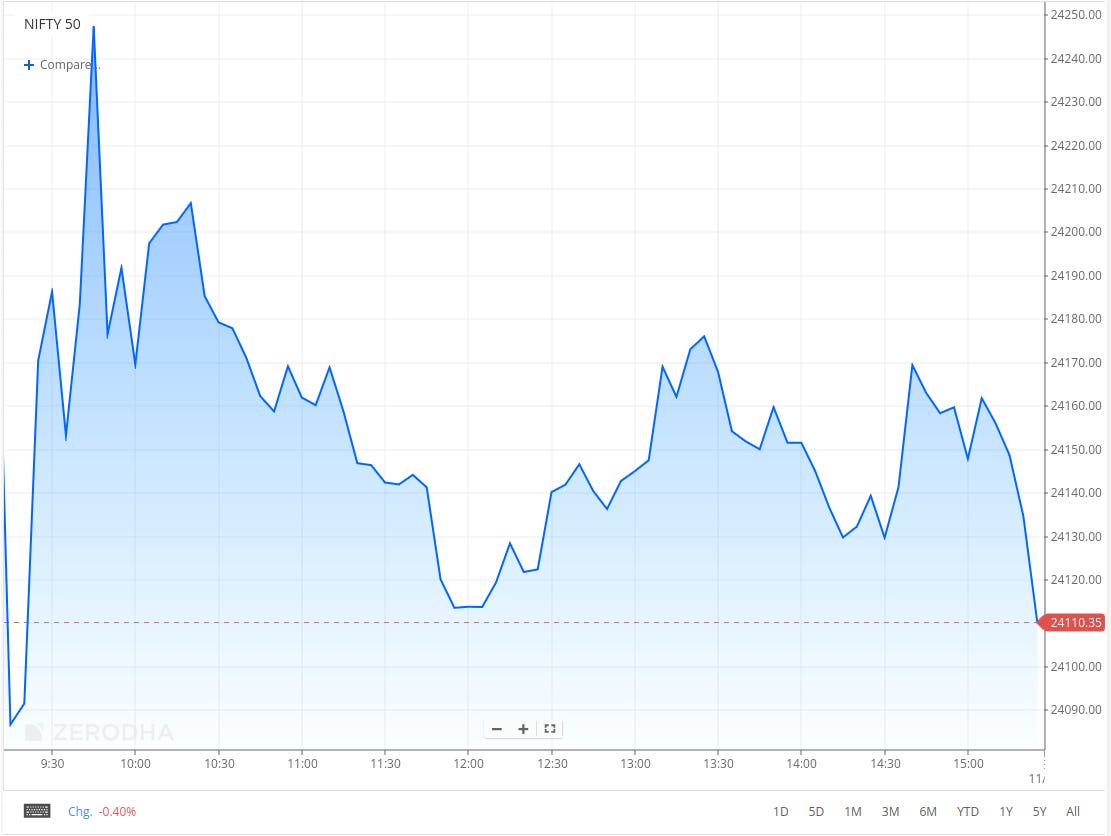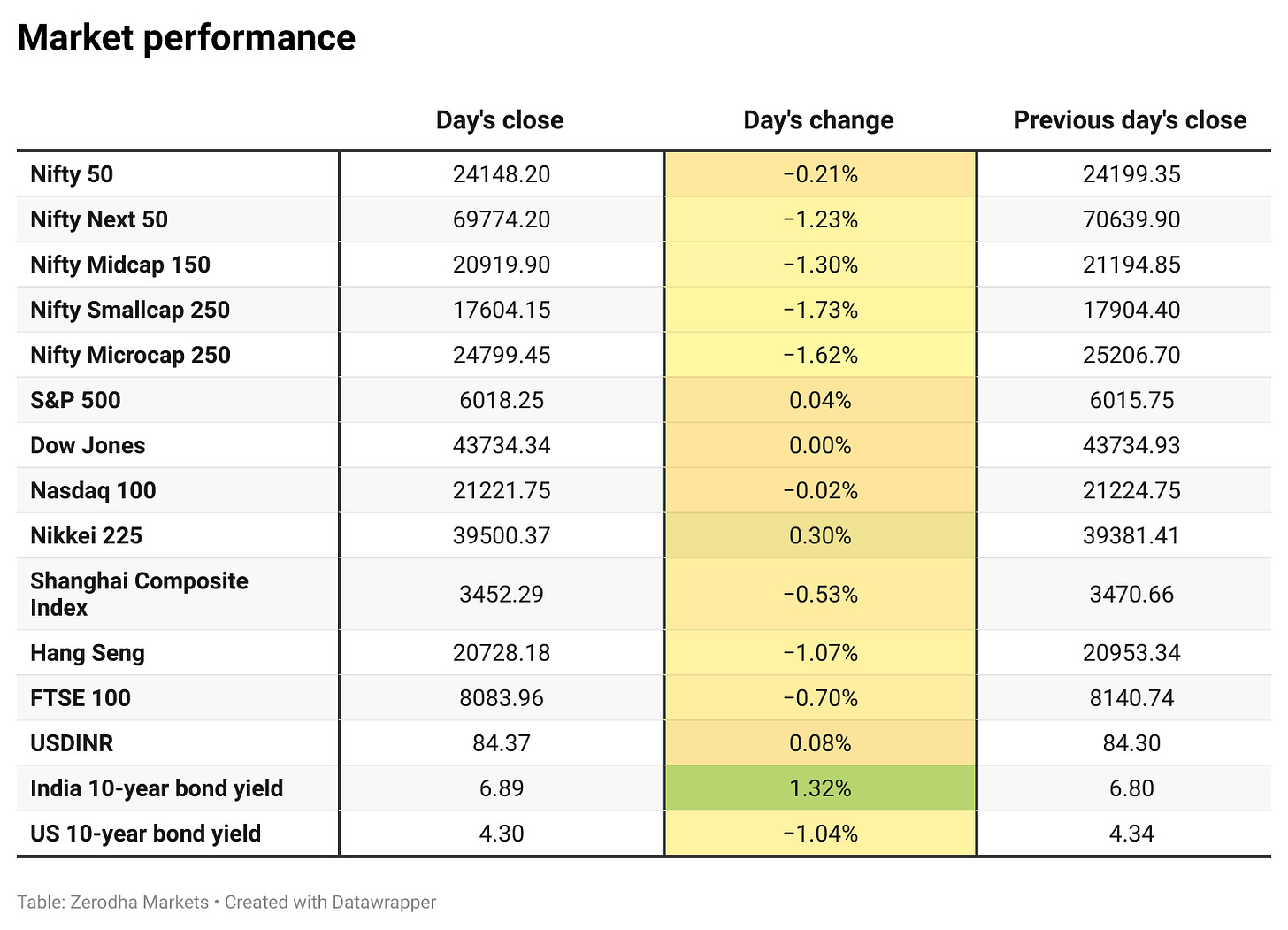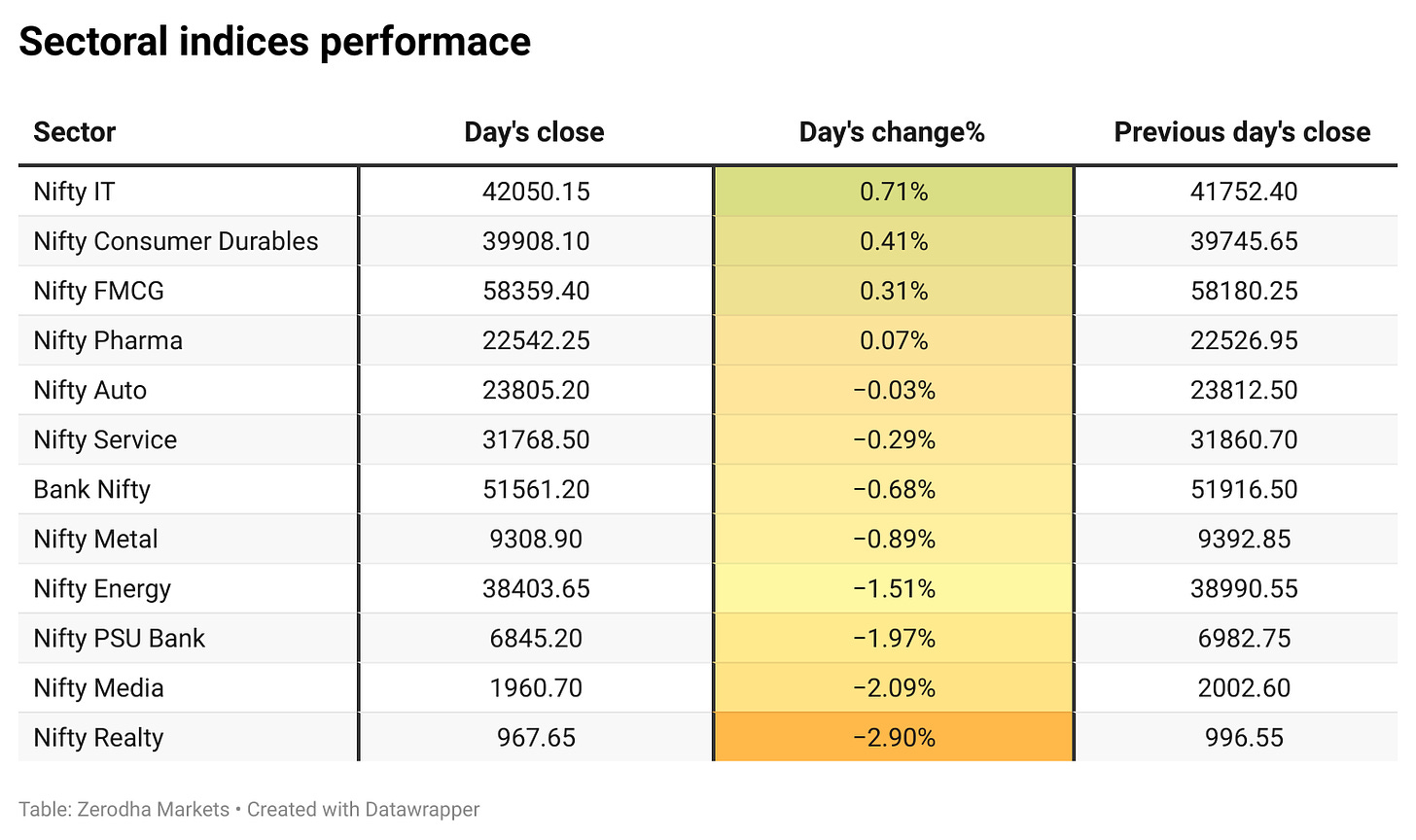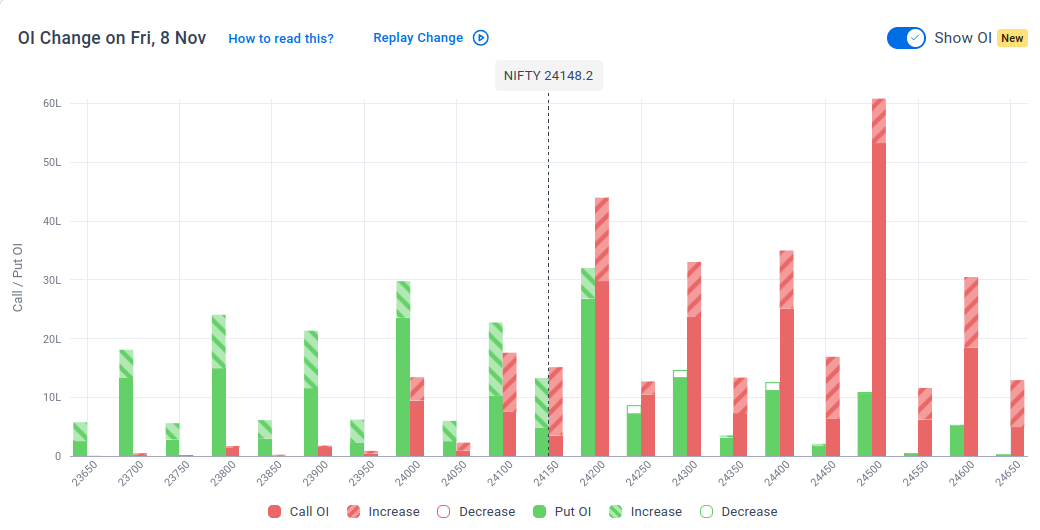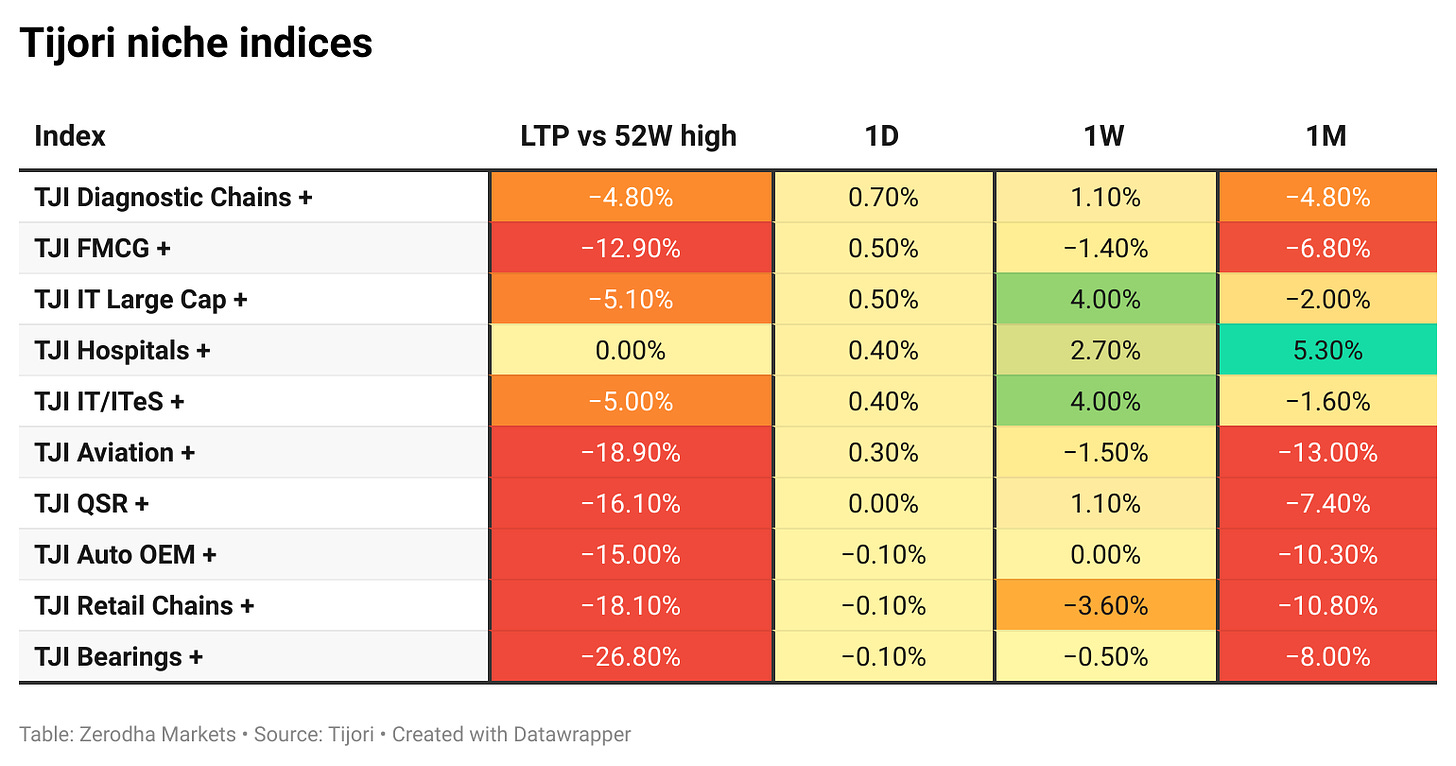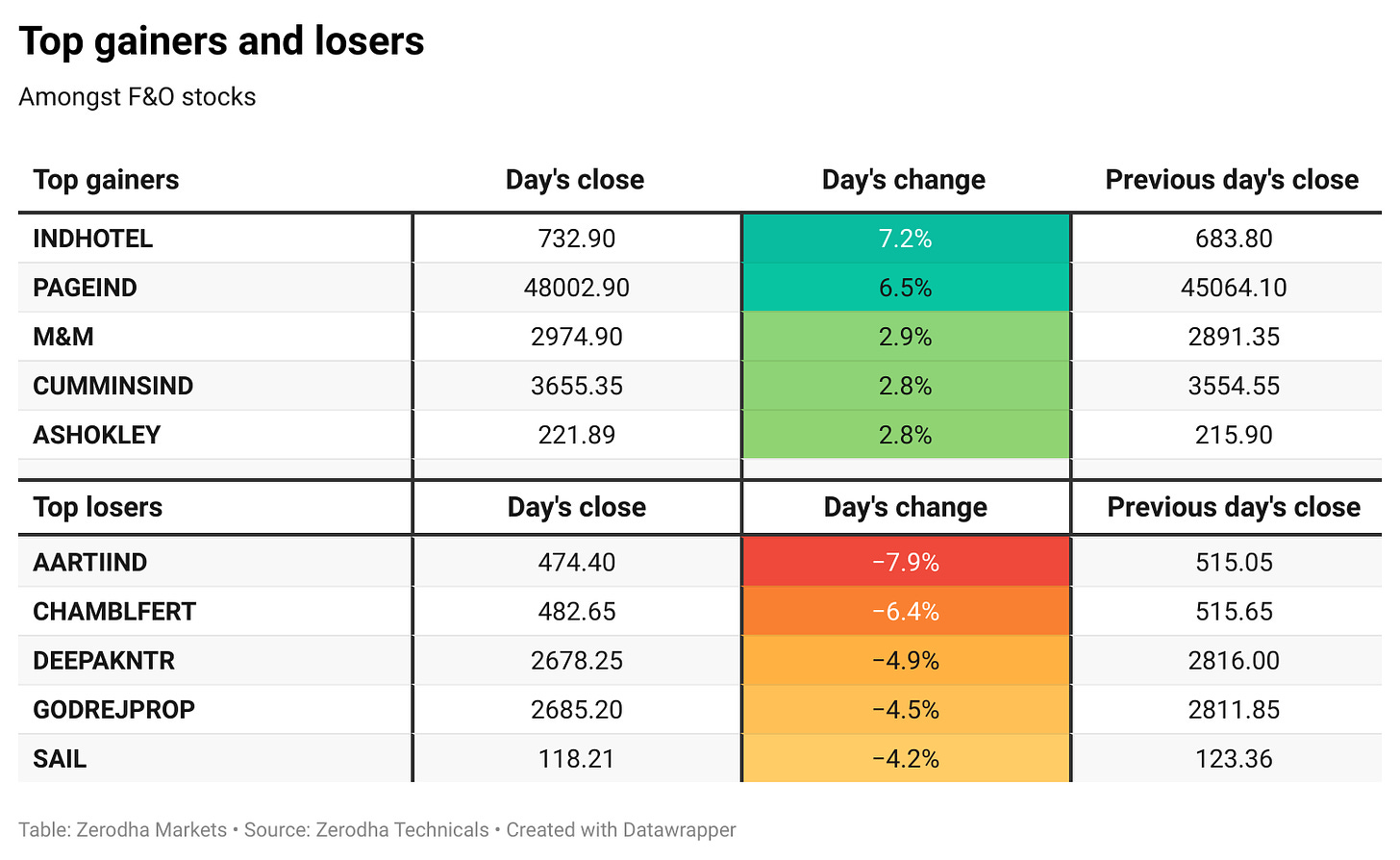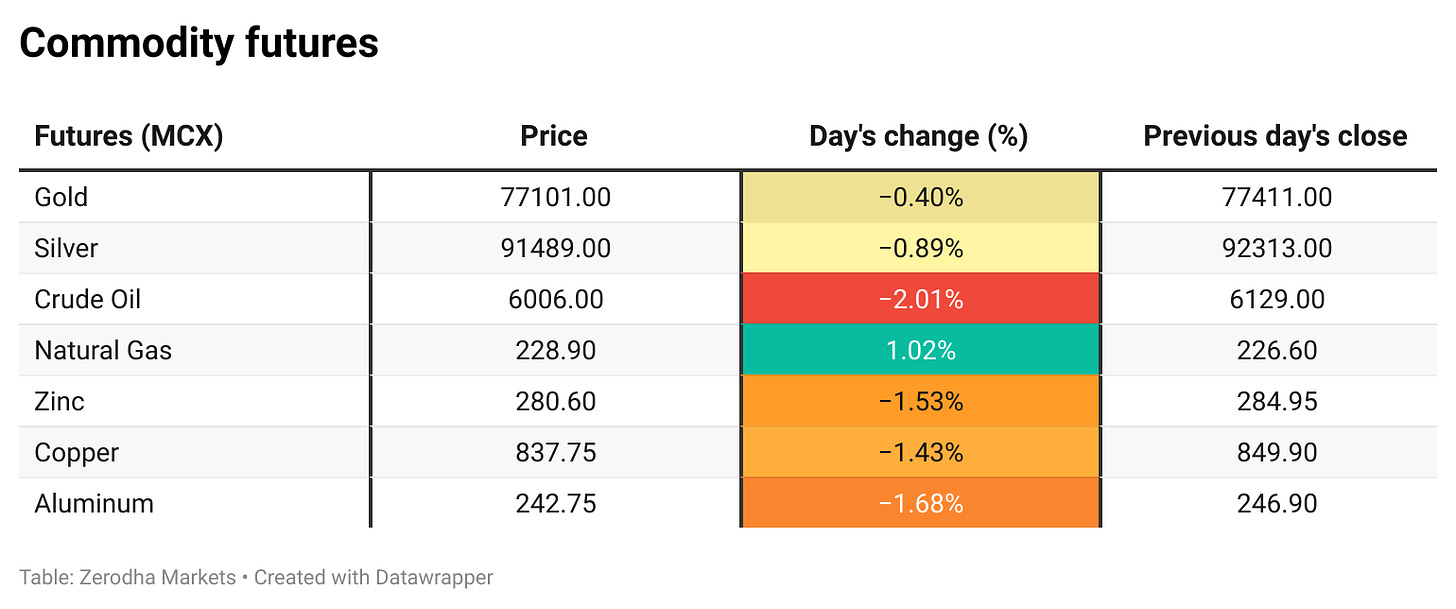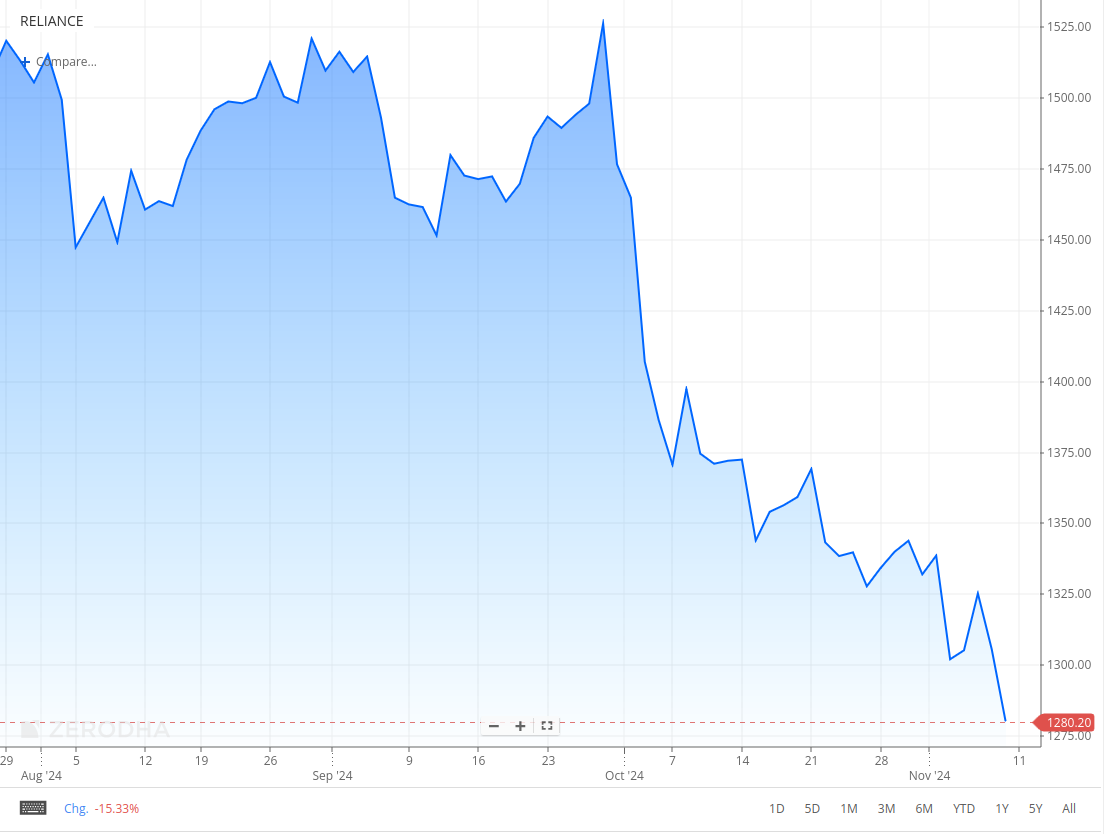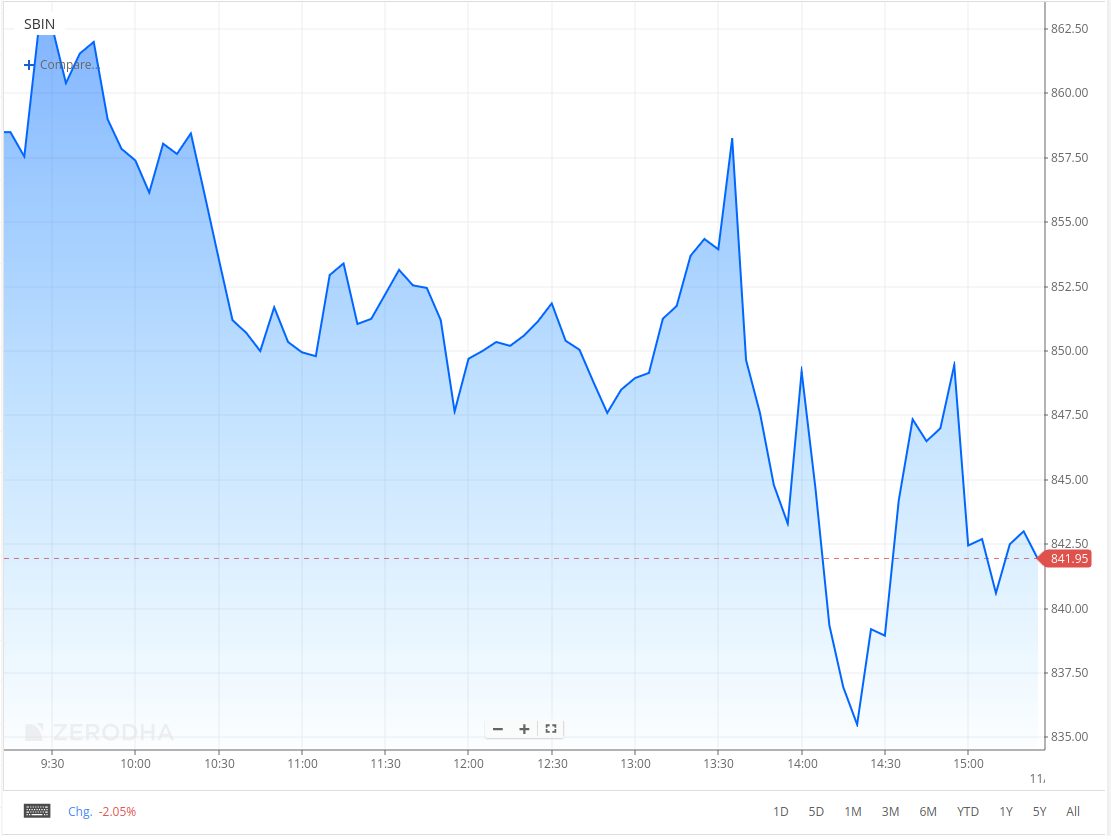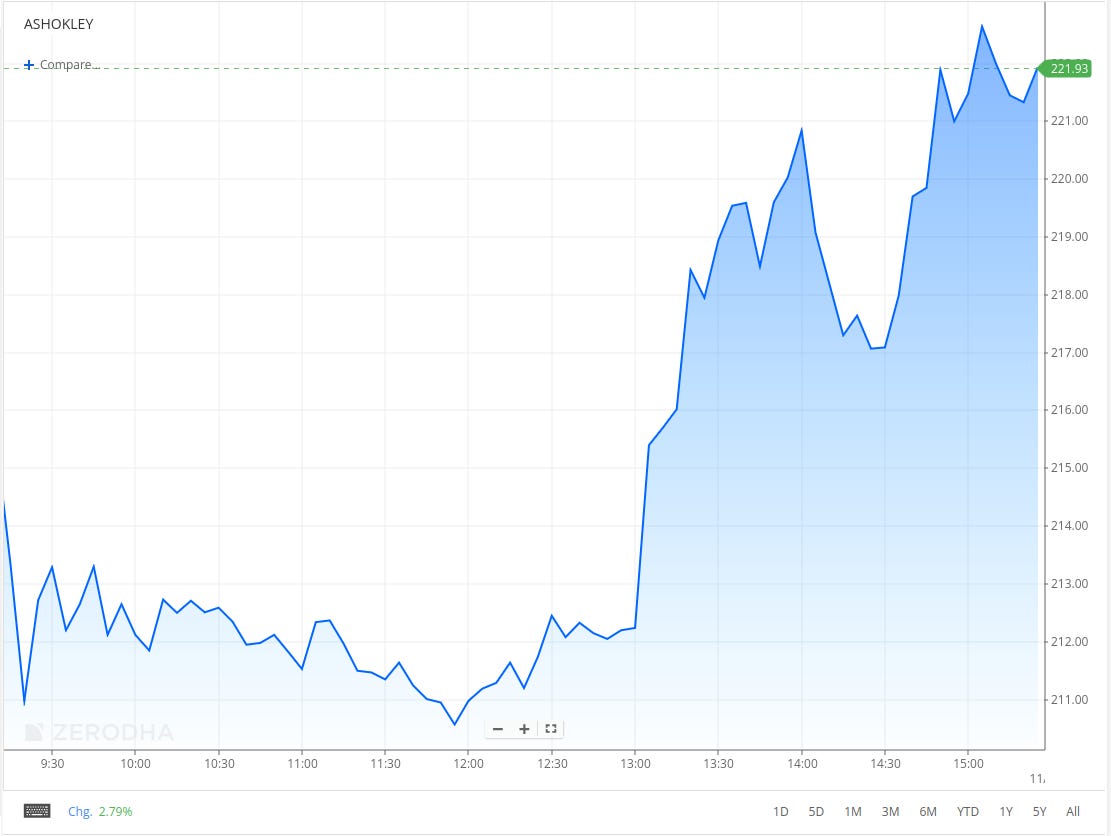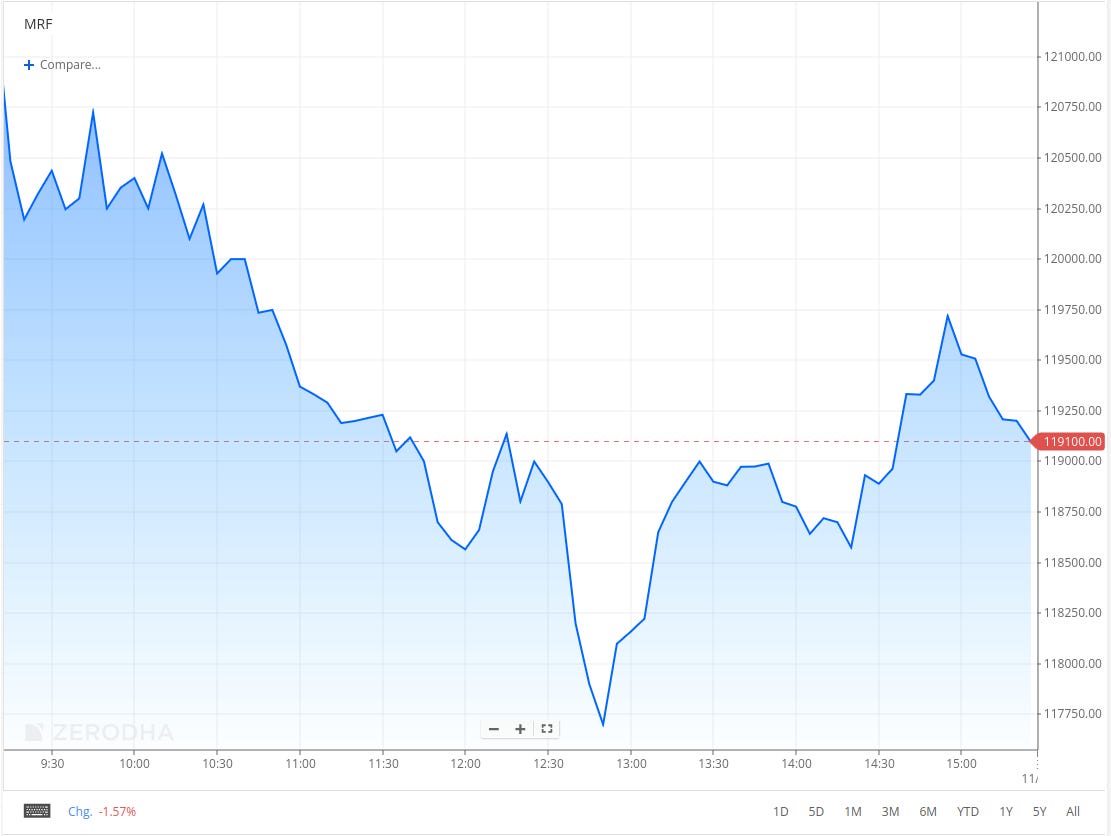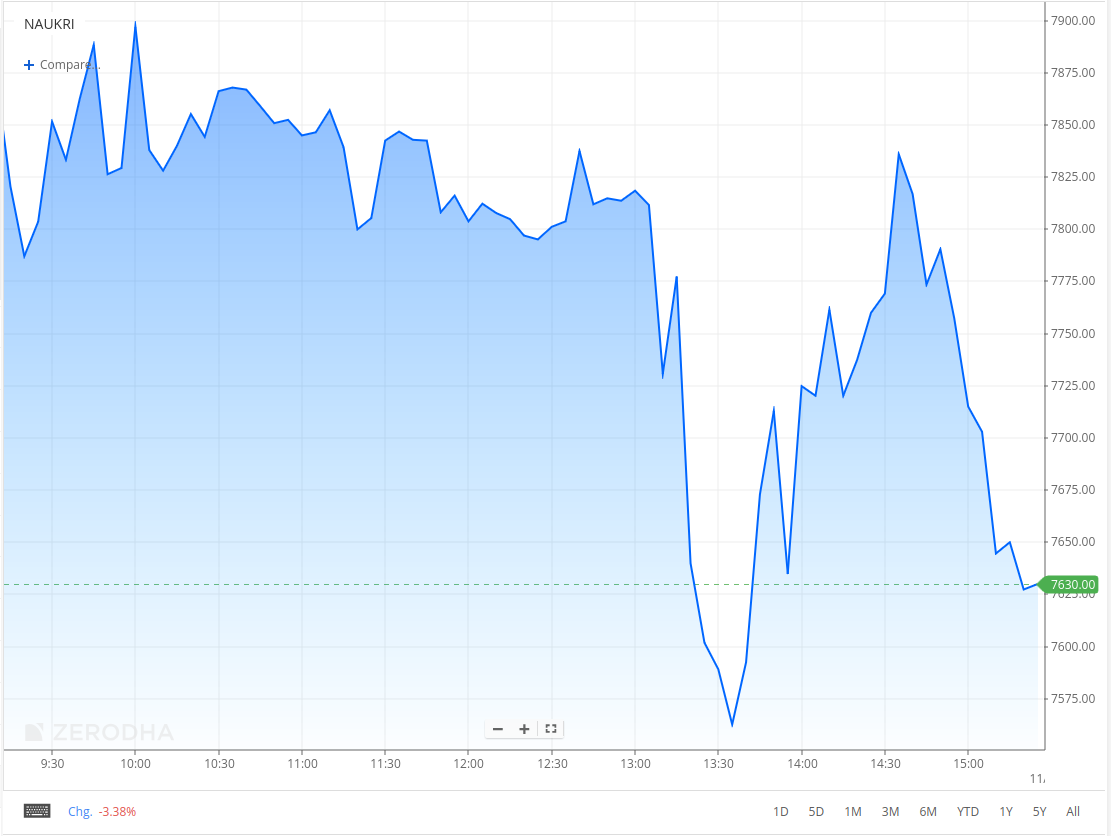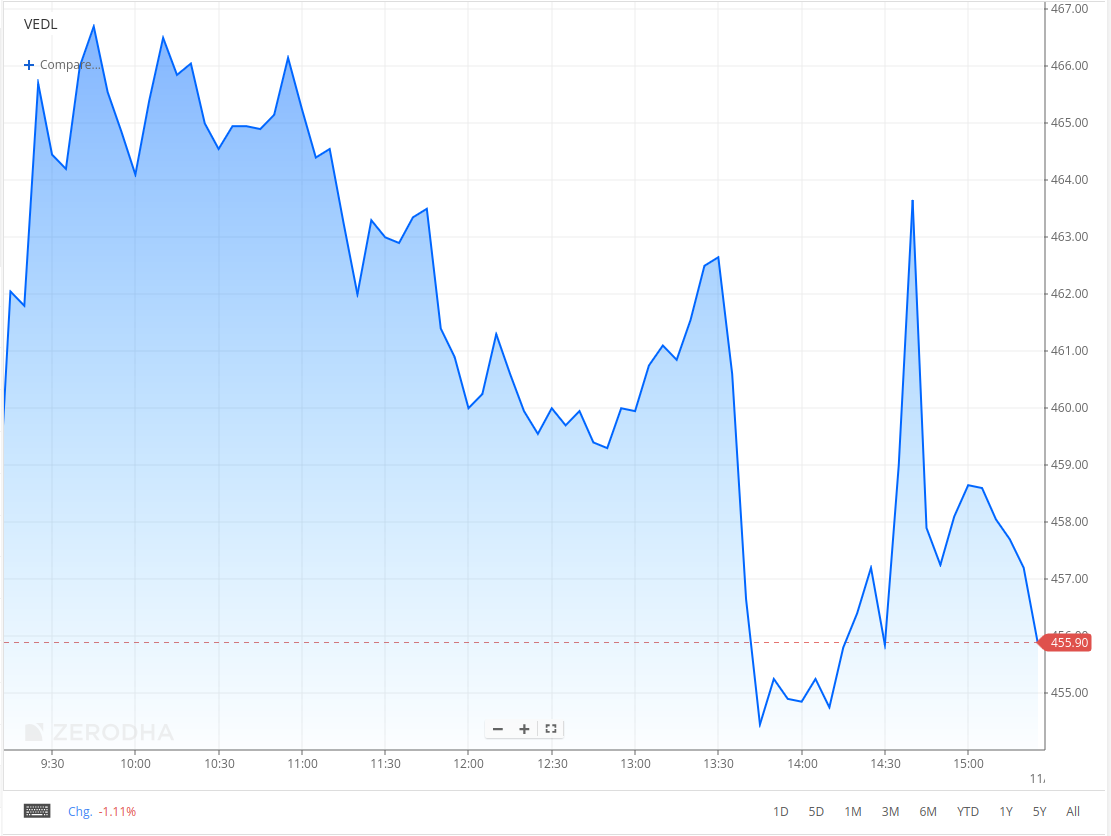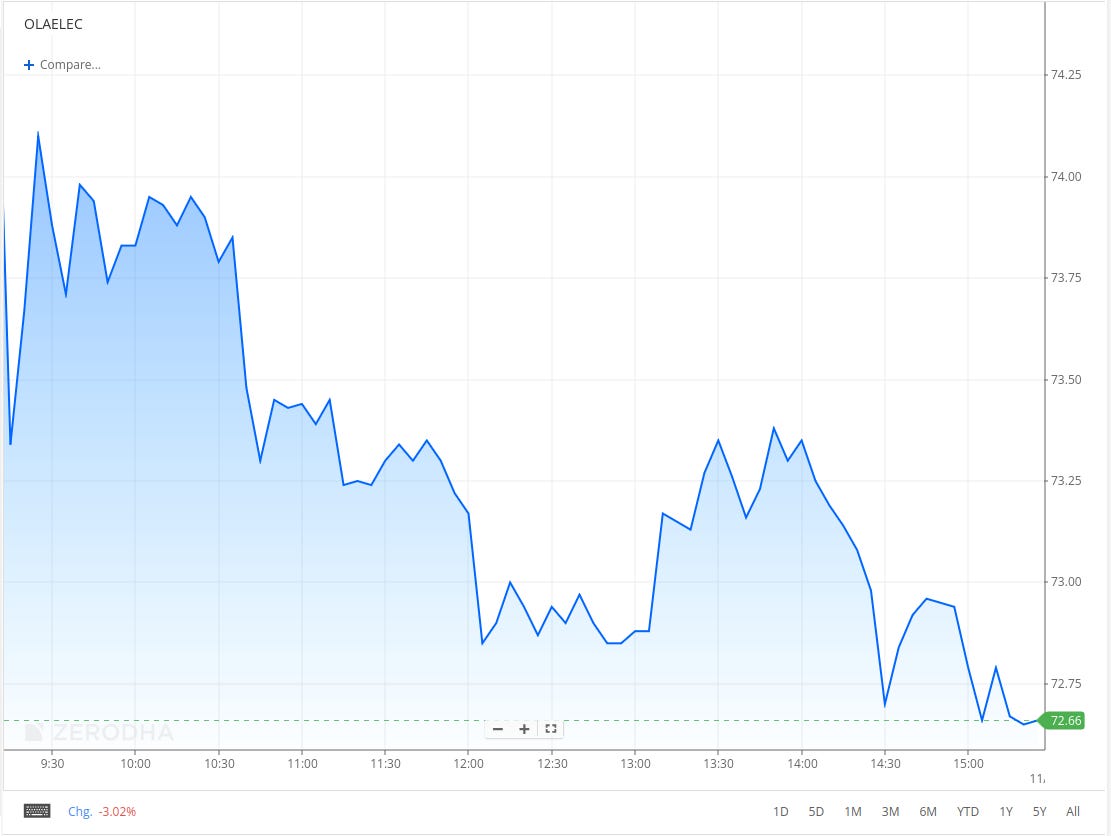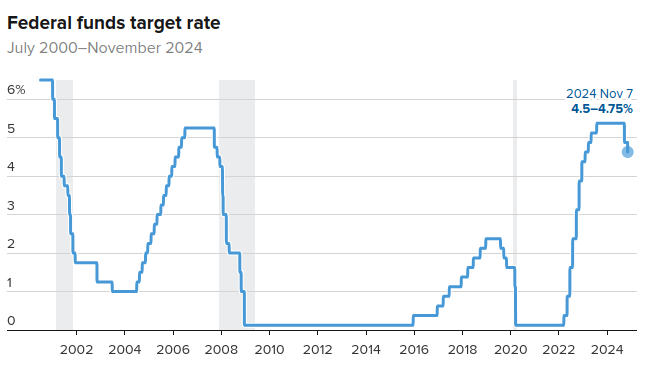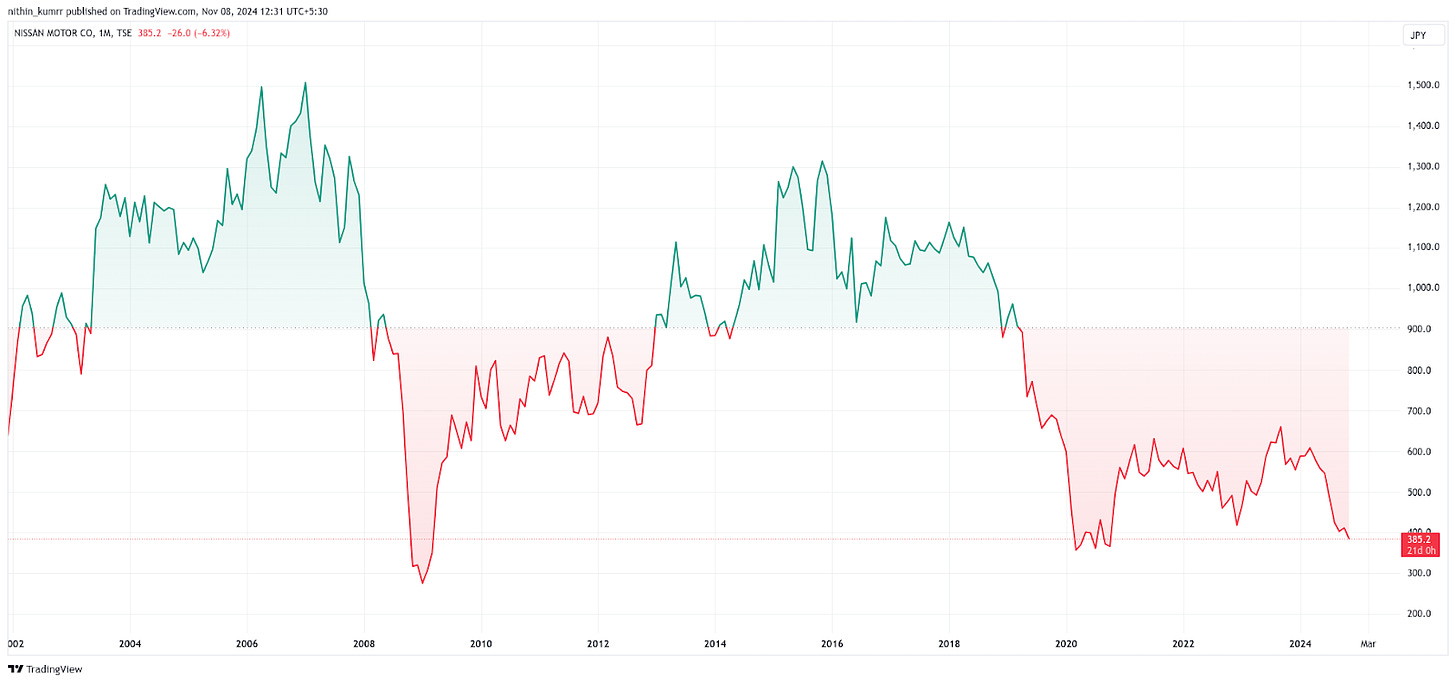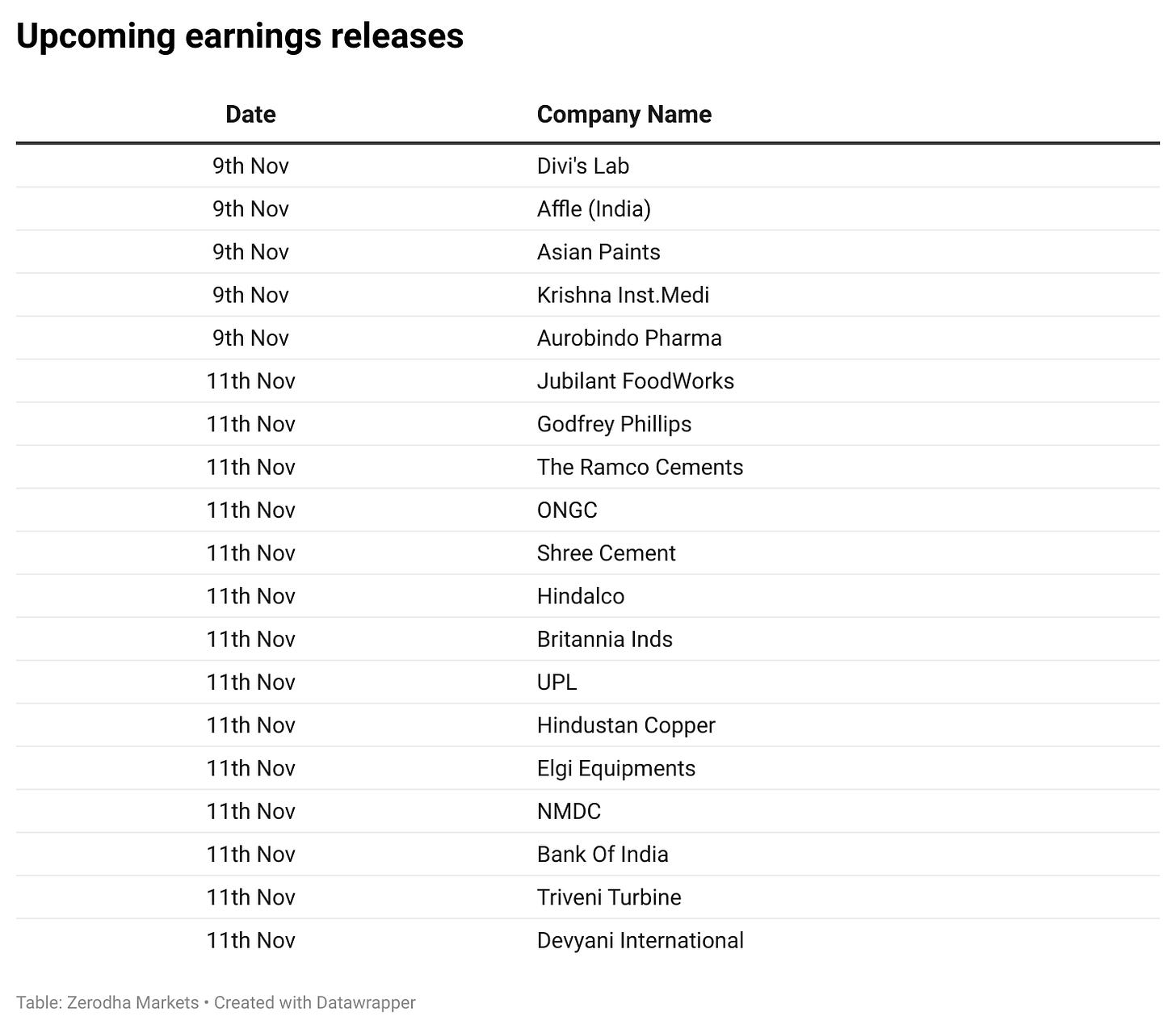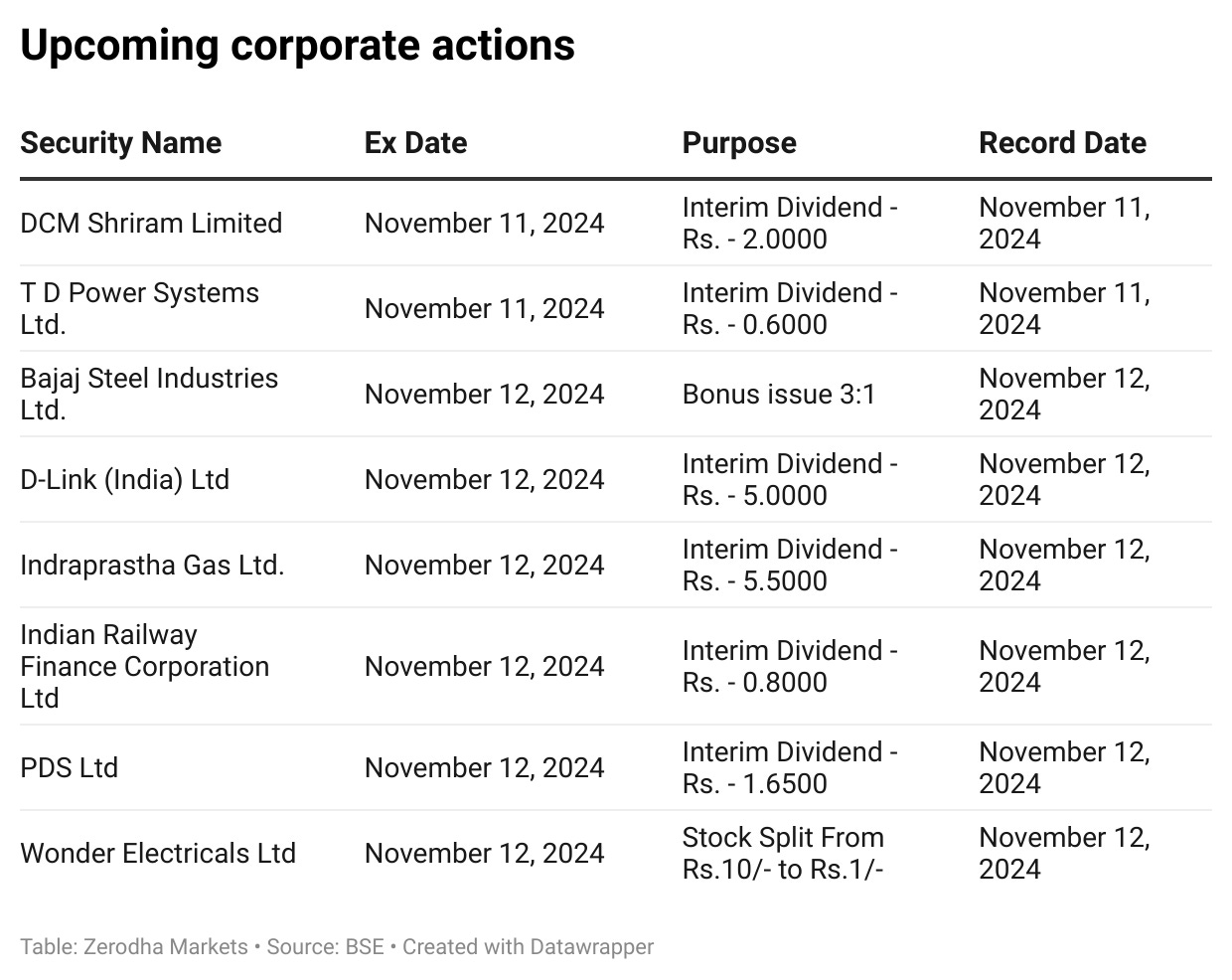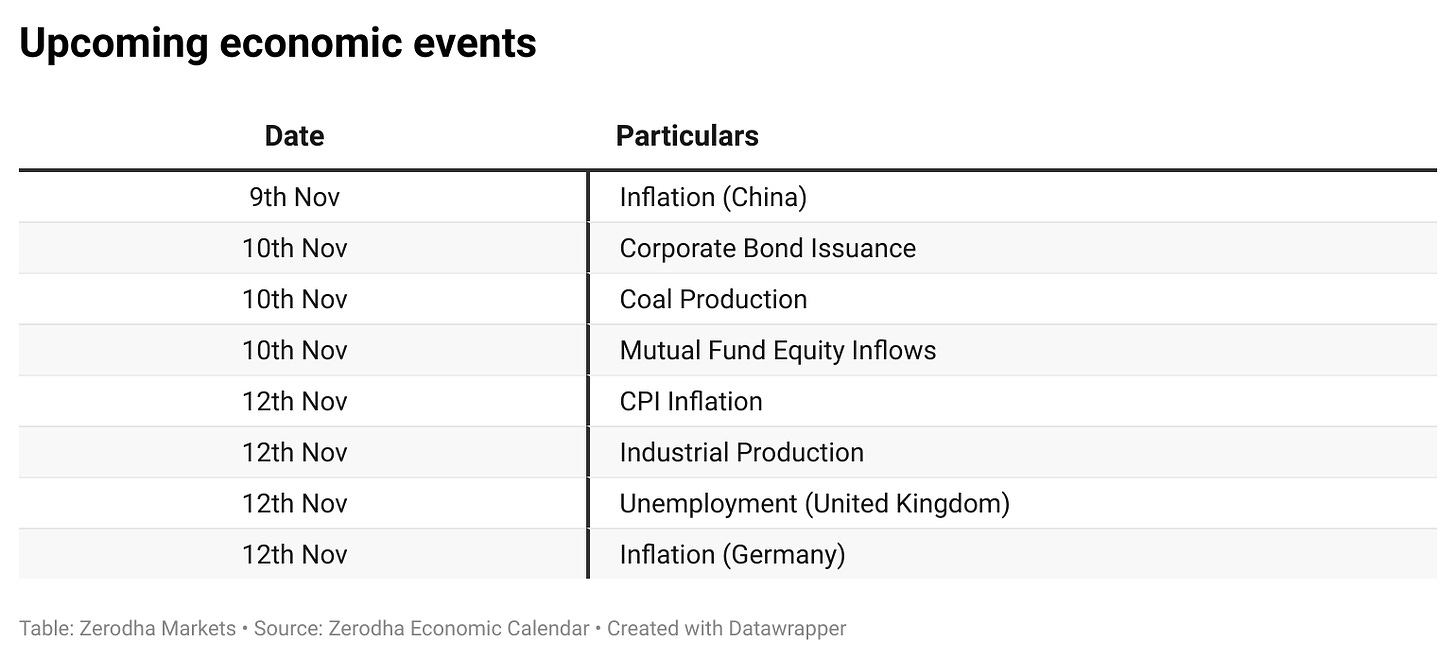Welcome to Aftermarket Report, a newsletter where we do a quick daily wrap-up of what happened in the markets—both in India and globally.
Market Overview
In a subdued trading session, the Nifty closed 0.21% lower at 24,148.20. While the main indices dipped, midcaps and small caps showed greater weakness, falling by 1.2% and 1.5%, respectively. On the NSE, 864 stocks advanced while 1,936 declined. Nifty IT gained 0.71%, benefiting from the Fed’s rate cut. Despite strong, expected results from SBI, the market reaction remained muted.
Change in OI for the day
The following is the change in OI for Nifty contracts expiring on 14th November
- The maximum CE OI is at 24500 followed by 24200 and Put OI is at 24200 followed by 24000
- 14.2 L OI got added to 24200 CE which was at 29.79 L contracts at the beginning of the day indicating massive addition of nearly 50%
- Immediate resistance can be seen at 24500 as we can see in the last few days.
Note: This is subject to multiple interpretations but generally, in a falling market if there is an increase in the call OI, it indicates resistance.
Source: Sensibull
Tijori is an investment research platform, and they have constructed niche indices for various themes and sub-sectors. They help you get a sense of the market performance of narrow slices of the market.
What’s happening in India
India’s e-way bill generation reaches record high
India’s supply chain activity grew significantly in October, with e-way bill generation reaching a record 117.25 million, a 17% increase from last year, according to data from the Goods and Services Tax Network (GSTN). This rise shows strong trade activity, driven by the festival season and higher manufacturing output.
What is an e-way bill?
An e-way bill is an electronic permit required for transporting goods within and across state borders in India. It helps monitor the movement of goods and ensures compliance with tax regulations.
Why?
- The festival season boosts trade and demand, leading to more shipments.
- Companies create more e-way bills as they clear inventory at the end of the financial year.
- More e-way bills suggest higher tax revenues since increased freight movement usually indicates a stronger economy.
- GST collections rose to ₹1.87 lakh crore in October, up 8.9% from last year.
- Manufacturing activity improved, with the HSBC India Manufacturing Purchasing Managers Index (PMI) rising to 57.5 in October, showing stronger demand.
Source: Livemint
Reliance Industries faces market challenges
What happened:
Reliance Industries Ltd. has lost nearly $50 billion (about ₹4.2 lakh crore) in market value since its peak in July. The company has struggled with weak earnings, trailing the NSE Nifty 50 Index significantly this year and missing profit estimates for the sixth consecutive quarter.
Why?
- Pressure from foreign sell-offs and concerns about earnings growth.
- At its annual meeting in August, Reliance announced a 1:1 bonus share issue but did not update investors on its telecom and retail unit listings.
- Reliance Jio lost subscribers after a tariff increase.
Source: Economic Times
Antitrust Probe finds Zomato and Swiggy in violation of competition laws
What Happened:
India’s antitrust body, the Competition Commission of India (CCI), found food delivery platforms Zomato and SoftBank-backed Swiggy in violation of competition laws as per a Reuters report
The investigation revealed that Zomato engaged in “exclusivity contracts” with partners in exchange for lower commissions, while Swiggy promised business growth to certain partners who listed exclusively on its platform.
Source: Money Control
Quarterly results
In this section, we’ll dive into all the key highlights from today’s intriguing results, covering the most impactful performances and standout moments. The numbers are comparable on a year-on-year (YoY) basis.
SBI (-2.05%)
What Happened:
- SBI’s Q2 net profit rose 28% YoY to ₹18,331 crore, up from ₹14,330 crore.
- Net Interest Income (NII) increased by 5% YoY to ₹41,620 crore.
- Gross NPA improved to 2.13% (from 2.21% QoQ), and Net NPA reduced to 0.53% (from 0.57% QoQ).
- The board approved raising up to ₹20,000 crore through long-term bonds.
Why?
- Strong profit growth was driven by increased NII and improved asset quality, as reflected in lower NPAs.
Ashok Leyland (2.79%)
What Happened:
- Q2 net profit rose 37.2% YoY to ₹756.4 crore,
- Revenue declined by 9% to ₹8,768.83 crore.
- EBITDA margin improved to 11.6%, up from 11.2% YoY.
- The company declared an interim dividend of ₹2 per share.
Why?
- Profit growth was driven by a focus on premium products, cost control, and improved operational efficiency.
- Revenue declined due to lower market demand, but robust performance in cost management supported profitability.
- International expansion in SAARC, the Middle East, Africa, and Asia contributed to revenue stabilization.
MRF (-1.57%)
What Happened:
- Q2 revenue rose 11.1% YoY to ₹6,760 crore
- Net profit declined by 20.4% to ₹455 crore.
- EBITDA decreased 14% YoY to ₹973.6 crore, with margins narrowing by over 400 bps to 14.4%.
- MRF declared an interim dividend of ₹3 per share, payable on November 29, 2024.
Why?
- The decline in net profit and EBITDA margin contraction were due to higher input costs and operational expenses, which pressured profitability despite increased revenue.
- Narrower margins reflect cost challenges in the tyre industry, reducing the company’s ability to maintain previous profit levels.
- Revenue growth was driven by steady demand, but profit was impacted by elevated costs, resulting in lower overall profitability.
Info Edge (-3.38%)
What Happened:
- Q2 FY25 net profit dropped 64.6% YoY to ₹84.73 crore
- Revenue from operations grew 12% YoY to ₹700.82 crore.
- Total expenses rose 8% YoY to ₹492.11 crore.
Why?
- The significant profit decline reflects increased expenses and lower profitability, impacting the bottom line.
- Revenue growth was driven by steady performance across its online platforms (Naukri, 99acres, Jeevansathi, Shiksha).
- Elevated operational costs and a challenging quarter-on-quarter comparison further compressed margins.
Vedanta (-1.11%)
What Happened:
- Vedanta reported a Q2 net profit of ₹5,603 crore
- Revenue declined 3.4% YoY to ₹37,634 crore
- EBITDA fell 14.4% YoY to ₹9,828 crore, with margins narrowing to 26.1%.
- Net debt reduced by ₹4,400 crore QoQ to ₹56,927 crore, with a net-debt-to-EBITDA ratio of 1.49.
Why?
- Lower tax expenses significantly supported profitability despite a slight revenue drop.
- Reduced net debt and improved debt-to-EBITDA ratio strengthened financial health.
- Strong performance in the Aluminium and Oil segments boosted revenue, offsetting challenges in other areas.
Ola Elec (-3.02%)
What Happened:
- Ola Electric reported a Q2 FY25 net loss of ₹495 crore.
- Revenue rose 39% YoY to ₹1,214 crore, with 98,619 units delivered, marking a 73.6% increase in sales volume.
- EBITDA loss narrowed to ₹379 crore, with a gross margin of 20.3%.
Why?
- Revenue growth was driven by increased unit deliveries and strong demand in the sub-₹1 lakh mass market segment.
- Improved cost control and operational efficiency at the Ola Gigafactory narrowed losses
- Expansion of store infrastructure aligns with growth ambitions - the company operates 782 stores and plans to expand to 2,000 locations by March 2025.
What’s happening globally
U.S. Federal Reserve cuts Interest rates
Source: CNBC
What happened:
The U.S. Federal Reserve cut interest rates by 25 basis points to a range of 4.5%-4.75%, marking the second cut in seven weeks. Following this decision, the Nasdaq rose by 1.5%, and U.S. bond yields fell, with the 10-year yield dropping below 4.35%. Fed Chair Jerome Powell stated that the election results won’t affect their near-term policy decisions.
Why?
The rate cut is intended to support stable prices and employment. However, there are mixed signals in the economy, including:
- Ongoing inflation concerns alongside weak job growth.
- The potential for inflation to rise under President-elect Trump’s policies.
- Expectations of a slower pace for future rate cuts.
- The Reserve Bank of India is scheduled to meet on Friday, December 6, 2024, to review its monetary policy.
Source: Yahoo Finance
China approves $839 billion debt swap plan
What Happened:
- China’s Standing Committee of the National People’s Congress (NPC) approved a $839 billion debt swap program to help local governments refinance their off-balance-sheet debt.
- The plan includes raising the local government debt ceiling to 35.52 trillion yuan, enabling the issuance of six trillion yuan in additional special bonds over three years.
Why?
- The initiative aims to curb financial risks and support economic growth amid slowing economic performance. China’s economy grew at a modest 4.6% in Q3, its weakest pace since March last year, casting doubt on meeting its 5% annual growth target.
- Policymakers are introducing more supportive measures, such as interest rate cuts and stock and real estate market assistance, to counter slow investment growth, weak consumption, and potential trade pressures under a second Donald Trump presidency.
Source: CNBCTV18
Nvidia surpasses $3.6 Trillion market value
What happened:
Nvidia’s shares reached a record high, making it the first company to exceed a market value of $3.6 trillion. The stock rose 2.2% following positive reactions to Donald Trump’s return to the White House, ending the day at $3.65 trillion, surpassing Apple’s previous record of $3.57 trillion. Apple’s shares also rose 2.1%, bringing its market value to $3.44 trillion. The S&P 500 technology index increased over 4% in the two sessions after the election.
Why?
Nvidia’s rise is driven by investor optimism about potential tax cuts and less regulation. The company is a leader in the AI race, with its stock up 12% in November and tripling in value this year. This strong performance positions Nvidia ahead of major competitors like Walmart and JPMorgan.
Source: Economic Times
Nissan makes major changes
What happened:
Nissan is facing tough times and has decided to make some big changes. The company will lay off 9,000 workers worldwide and cut production by 20%. This comes after a 94% drop in net income for the first half of the fiscal year. Nissan will also sell part of its stake in Mitsubishi Motors after losing ¥448.3 billion ($2.9 billion) in cash over the last six months. CEO Makoto Uchida will give up half of his salary due to these results.
Why?
Nissan’s problems are linked to more competition from Chinese automakers and possibly setting sales targets that were too high. The company has lowered its income forecast for the year to ¥150 billion ($1 billion), a significant drop from earlier expectations. Sales in key markets like China, Japan, and North America have been weak, making it difficult to meet production goals. There is also a growing demand for hybrid vehicles, suggesting that improvements to the product lineup are needed to remain competitive.
Management chatter
In this section, we pick out interesting comments made by the management of major companies.
Rajeev Juneja, Vice Chairman and Managing Director, Mankind Pharma Ltd.
The company aims to become a debt-free company within the next three years. In the next few weeks, hopefully, in the middle of December, a Rs 3,000-crore QIP will happen. Plus, we have some non-core assets to the tune of Rs 500 crore to Rs 600 crore. They will be sold off and the money will go for the debt repayment,” he said. “We are making quite a discipline that our debt-to-ebitda (ratio) should not be more than two times - Link
Puneet Chhatwal, MD & CEO, Indian Hotels
The Sector is in for a very good run and the demand is outpacing supply. We think that the best is yet to come, H2 will see strong growth. We’re targeting margins to be around 40% in FY25 backed by strong H2. - Link
Calendars
In the coming days, We have the following quarterly results and other major events:
That’s it from us. Do let us know your feedback in the comments and share it with your friends to spread the word.

